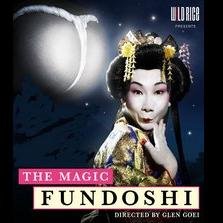A Lazy Weekend to be spent...(Part 1/3)
Last Friday, I did not meet up with my new friend cos I was not feeling well. I got a flu-like symptom so I decided not to meet him anyway. So, I sms-ed Gilbert where he was as I knew that he would be watching Fundoshi - a comical satire to make fun of the Singapore government's media censorship. I have given a little introduction about the Fundoshi 褌(ふんどし) in the next paragraph. So, prior to meeting Gilbert at Raffles Hotel, I browsed through the photography section and found a very interesting book Wildlife Photography which was commissioned by BBC to cover award-winning outdoor photographs for two decades. As I browsed through the book, all these award-winning photos simply blew me away and instilled renewed inspiration in me, firing up fleeting imaginations in my mind. One photo captures a lonely white toadstoal amidst the moss-covered rocks with sinister-looking trees in the backdrop. It was like I was running with Hobbits in our hasty escape from the Orcs in the Lord of the Ring movie. After much contemplation, I decided to shell out money to buy it before I rushed off to meet Gilbert. We chatted for an hour while he was eating his dinner and then we went off together to the National Library. Nicholas, Gil's friend would be probably waiting for Gilbert there at the third floor and then i went off home.
ふんどし
Fundoshi (褌)
 The Magic Fundoshi is a saucy comedy made up of three parables poking fun at human frailties and our fleshly instincts.
The Magic Fundoshi is a saucy comedy made up of three parables poking fun at human frailties and our fleshly instincts.With naughtily sparkling wit, wacky slapstick action and sumptuous sets and costumes, The Magic Fundoshi promises an exuberant evening of pure unadulterated joy!
Glen Goei sets out to outdo last year’s smash hit comedy Boeing Boeing with a brand-new revival of his award winning production.
This exciting production stars an outstanding ensemble comprising Singapore’s favourite and most versatile comedians: Hossan Leong, Jonathan Lim, Koh Boon Pin, Robin Goh and a special appearance by Emma Yong.
The Perfect Servants
The servants of two noble Japanese households are willing to do anything and everything to uphold the public reputations of their lazy master and mistress. Their determination to keep up appearances leads to hilarious consequences when they find themselves staging a passionate courtship on behalf of their employers – from writing letters and serenades, to a full-blown hair-down legs-up lovers’ rendezvous!!
The Magic Fundoshi
Taro-Kaja has left his fundoshi at his mistress’ home, and must find a replacement before his wife discovers his infidelity. With a cunning strategy inspired by “the emperor’s new clothes”, he tricks a passing samurai into giving up his fundoshi (loin cloth) in exchange for a ‘magic’ one - which is only visible to adoring female eyes!
The Misplaced Goddess
When the revealingly-dressed statue of the Goddess of Love and Potency goes missing, two sham priests and two lecherous pilgrims frantically take turns posing as the statue to avoid being accused of stealing it. The shenanigans escalate into a riotous wild-goose chase - but there’s more to come! Soon, the Goddess herself appears….
Reviews
“A bawdy, delightful, laugh-a-minute outing. The Magic Fundoshi is a fine, and
increasingly rare, celebration of pure, mindless comedy.” SPH - The Straits Times
“Highly entertaining, intelligent in its subtlety and hilarious in its high comic drama.” SPH - The Business Times
Background
The form of Japanese comedy known as Kyogen (狂言) developed around 1400 as comic interludes between Noh dramas. These classical Japanese kyogen (literally ‘wild words’) provided a dazzling contrast and light-hearted relief from the bleak, slow-moving Noh (能) plays; and to this day, kyogen still has Japanese audiences rolling in the aisles in laughter.
Kyogen are delightfully everyday celebrations of human foibles; and lust, sloth, vanity and other human appetites are the stuff of which kyogen is made. The traditional kyogen repertoire features whimsical tales of the Everyman (and woman) – of servants outsmarting their masters and scheming tricksters getting into bizarre screw-ups - always playful, always mischievous, always hilarious.
In 1966, Donald Richie, one of the foremost Western authorities on Japanese culture, in particular theatre and cinema, wrote 3 plays which he labeled ‘modern kyogen’. He based these plays on his extensive knowledge and experience of the kyogen form, but made them more accessible to Western audiences by giving them a contemporary attitude and a playful respect for the foreign language – English – in which they are written. The first performance, in Japanese, premiered to great success in Tokyo in 1969.
In 1993, Glen Goei, as Artistic Director of Mu-Lan Theatre Company, brought the trilogy to the attention of the English-speaking world by staging the World Premiere of the English version in London. He christened this production “The Magic Fundoshi” (the title of the second play in the trilogy). The production was a huge success with audiences and critics alike, and won the London Sunday Times Award for Best Comedy that year. This production toured successfully to Singapore in 1994 and 1996. Donald Richie’s Three Modern Kyogen have since been staged in Japan, Australia and the USA.
A little glimpse into Japanese culture on Noh and Kabuki
When I was in Tokyo staying with my ex in Jiyugaoka 自由が丘(じゆうがおか), most of the time, I was on my own exploring the Old Tokyo (Edo - 江戸)which was around Asakusa (浅草)and certain part of Ginza (銀座). As I was walking down the Ginza street which is the famed for most expensive street in the world, I saw a famous traditional Kabuki (歌舞伎) theatre which looked rather quainty. What really striked me was its interesting Japanese facade with purple curtains in front and quite a number of kimono-clad patrons thronged through this theatre.
Kabuki (歌舞伎, kabuki) is a form of traditional Japanese theater. Kabuki theater is known for the stylization of its drama and for the elaborate make-up worn by its performers.
Noh or Nō (能) is a major form of classical Japanese musical drama that has been performed since the 14th century. Together with the closely-related kyogen farce, it evolved from various popular and aristocratic art forms, including Dengaku, Shirabyoshi, and Gagaku. Kan'ami and his son Zeami brought Noh to its present-day form during the Muromachi period. It would later influence other dramatic forms such as Kabuki and Butoh. During the Meiji era, although its governmental patronage was lost, Noh and kyogen received official recognition as two of the three national forms of drama.
Noh is unique in its slow, spartan grace and its use of distinctive masks.
Noh is a chanted drama, and for that reason, some people have dubbed it Japanese opera. However, the singing in Noh involves a limited tonal range, with lengthy, repetitive passages in a narrow dynamic range. Clearly, melody is not at the center of Noh singing. Still, texts are poetic, relying heavily on the Japanese seven-five rhythm familiar to all who know the earlier waka and the much-later haiku, with an economy of expression, and an abundance of allusion.
Then I continue to the part 2 cos I do not want my posting to be very lengthy.


0 Comments:
Post a Comment
<< Home